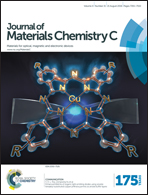Water dispersed fluorescent organic aggregates for the picomolar detection of ClO4− in water, soil and blood serum and the attogram detection of ClO4− in the solid state by a contact mode method†
Abstract
Fluorescent organic aggregates (FOAs) of CS-1 have been used for the fluorescence based selective estimation of ClO4− ions. CS-1 undergoes self-aggregation to form FOAs (ϕ = 0.35) with a diameter of 140 ± 50 nm in aqueous medium. Dynamic light scattering and field emission scanning electron microscopy studies reveal that FOAs of CS-1 undergo further aggregation to form larger particles upon addition of ClO4− (10 pM–1 nM concentration) but at higher concentrations of ClO4− ions, these FOAs undergo dis-aggregation to give finally a molecularly dissolved complex of CS-1 and ClO4−. This ClO4− induced aggregation–dis-aggregation process of FOAs of CS-1 is associated with super-amplified fluorescence quenching following two domains of non-linear complexation with Ksv values of 2.42 × 108 M−1 and 3.59 × 105 M−1 and variation in the lifetime measurements of FOAs of CS-1 at different concentrations of ClO4−. The lowest limit of detection is 10 pM in solution and 6 × 10−18 g cm−2 in the solid state by a contact mode method with a selectivity of ∼10 000 over other inorganic anions and allows the quantitative measurement of ClO4− ions using front surface steady state fluorescence of paper strips coated with CS-1. FOAs of CS-1 find applications in the determination of ClO4− in tap water, soil and also blood serum. Probe CS-2, which differs from CS-1 in lacking three methyl groups on the m-phenylene spacer, shows poor sensitivity (LOD 1.6 μM) towards ClO4−. DFT studies of CS-1 and CS-2 and their complexes with ClO4− reveal the effect of methyl substituents on their geometries.


 Please wait while we load your content...
Please wait while we load your content...